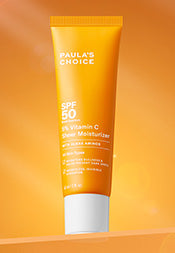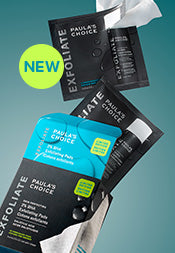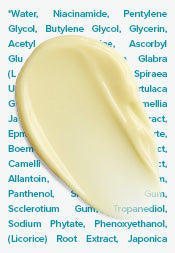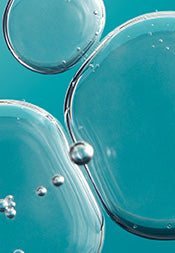What to Do When You Have Acne and Dry Skin
Caring for dry, acne-prone skin requires a unique approach that nourishes skin while clearing up breakouts gently. Finding the right products that can help tackle dry, acne-prone skin can result in beautifully smooth, clear, and hydrated skin.
Start with a soothing cleanser & toner for dry, acne-prone skin
This replenishing duo leaves skin soft and completely makeup and oil-free.
 |
CALM Cleanser For | Normal to Dry Skin Leaves skin thoroughly cleansed, yet replenished and soft. |
 |
CALM Toner For | Normal to Dry Skin Soothes redness while replenishing skin for renewed radiance. |
Fight breakouts with the best acne treatment for dry skin
Choose products that effectively, gently, and quickly combat acne and clogged pores.
 |
CLEAR Regular Strength Exfoliating Solution with 2% BHA Unclogs pores and minimises breakouts in a dramatic yet soothing way. |
 |
CLEAR Regular Strength Daily Skin Clearing Treatment with 2.5% Benzoyl Peroxide Disrupts the causes of acne and stops breakouts before they begin. |
Hydrate & Replenish with the best moisturizer for dry, acne-prone skin
Give skin the moisture it needs while getting the smooth, clear complexion you want.
 |
CALM Daytime Moisturizer SPF 30 For | Normal to Dry Skin Gentle mineral-based sunscreen with soothing plant extracts to minimise redness while protecting from UV damage. |
 |
CLEAR Oil-Free Moisturizer For | All Skin Types Lightly moisturizing gel-lotion hybrid with a unique formula that helps balance skin. |
Is it possible to have dry skin and acne?
Though most people associate having acne with oily skin, it is possible to have dry skin and acne too, though only a small percentage of people fall into that category. For those few with dry skin and acne breakouts, it’s an infuriating struggle.
Trying to find a moisturizer that addresses dry skin needs without clogging pores and causing more breakouts is hard enough. Then there’s the issue: products that control breakouts often make dry skin even drier. So, it can be a real dilemma when shopping for skincare products.
Note: if your skin feels tight and dry, yet also oily and prone to breakouts at the same time, you’re struggling with dehydrated skin and acne, which is very different from dry skin and acne. Dehydration is typically triggered by using the wrong skincare products, such as overly drying cleansers or harsh ingredients like denatured alcohol, mint, menthol, eucalyptus, and lemon.
If your skin feels flaky and tight after washing – even when using gentle products and proper moisturizers – you have dry skin.
How to treat dry and acne-prone skin
Once you’ve determined that your skin is dry (not dehydrated) and that your skincare routine is free of aggravating factors, you can focus on the gentle yet effective ways to control your dry skin and acne. The following are our expert recommendations.
Every product in your routine should be gentle and respect the skin's microbiome. The microbiome plays a critical role in skin defences and overall health; disrupting it can worsen all skin concerns, including acne.
Start with a soothing cleanser and toner duo, like you’ll find in our CALM collection for normal to dry skin, to leave skin cleansed thoroughly yet replenished and soft (4). This combination is formulated for the most sensitive of skin and is even gentle enough for skin prone to eczema.
Bring in the rainmakers with a gentle BHA (beta hydroxy acid) exfoliant to unclog pores. Our SKIN PERFECTING 2% BHA Lotion Exfoliant has a light lotion texture that softens and hydrates as it gently and naturally exfoliates. The non-drying exfoliation clears pores deeply and reveals bump-free, smooth-looking skin. A leave-on BHA exfoliant also reduces the appearance of those hard, tiny, white bumps on the cheeks and face and is even suitable for skin prone to milia.
Stop breakouts before they begin with benzoyl peroxide. Benzoyl peroxide is a powerhouse ingredient for preventing acne eruptions before they happen (1). Use it consistently in your breakout-prone areas, give it a couple of weeks, and you will see what we mean! Higher concentrations, particularly 10%, can be drying for many people, so we strongly recommend starting with a 2.5% concentration, like in our CLEAR Regular Strength Daily Skin Clearing Treatment, and see how your skin responds. As you monitor your skin’s response, you can slowly increase the percentage of benzoyl peroxide, if needed, for breakouts.
Find the perfect balance in a moisturizer and/or serum. This is admittedly the tricky part. You want a moisturizer and/or serum that contains rejuvenating, skin-renewing ingredients and is hydrating enough to quench dry skin. It also needs to be less emollient than a standard cream moisturizer, so it doesn’t clog pores and amplify breakouts. While it may take some experimenting, here are a few of our suggestions, starting with the lightest texture option in each category first.
Daytime moisturizers with SPF 30 or greater (you simply can’t take care of any skin type and overlook this fundamental skincare step):
RESIST Youth-Extending Daily Hydrating Fluid SPF 50 (lightweight, fluid formula loaded with key antioxidants)
CALM Daytime Moisturizer SPF 30 (Normal/Dry) (creamy formula combines gentle mineral-based sunscreen with soothing plant extracts to minimise redness, suitable for sensitive skin)
Nighttime moisturizers:
RESIST Anti-Aging Clear Skin Hydrator (one-of-a-kind, anti-ageing gel-lotion hybrid that lightly moisturizes skin)
RESIST Barrier Repair Moisturizer (moisturizing cream that reinstates skin’s natural balance and kicks anti-ageing into gear)
Serums:
CALM Repairing Sensitive Serum (non-greasy, lightly hydrating, antioxidant-enriched formula that smooths over the skin)
RESIST Intensive Wrinkle-Repair Retinol Serum (velvety serum blends pure retinol and potent antioxidants to leave skin feeling silky and soft)
Learn more about dry skin.
Shop science backed skincare for dry skin.
References for this information:
Expert Review of Clinical Pharmacology, May 2021, pages 687–701
Journal of Drugs in Dermatology, November 2020, pages 1,069–1,075
Sumatera Medical Journal, Volume 3, January 2020, ePublication
Dermatologic Clinics, April 2016, pages 133–145
Journal of Clinical and Aesthetic Dermatology, February 2013, pages 18–24
American Journal of Clinical Dermatology, August 2012, pages 1–6









